Planning worship?
Check out our sister site, ZeteoSearch.org,
for 20+ additional resources related to your search.
- |
User Links
Person Results
Meir ben Isaac Sheli'ah Zibbur
996 - 1096 Person Name: Meir Ben Isaac Nehorai Topics: Adoration and Praise God Our Father Author (st. 3) of "The Love of God" in The Celebration Hymnal
Meir ben Isaac Sheli'ah Zibbur
August Rische
1819 - 1906 Topics: Adoration and Praise Author of "For God So Loved Us" in Moravian Book of Worship
August Rische
Twila Paris
b. 1958 Topics: Adoration; Praise, Adoration, Worship, Exaltation of God; Praise, Adoration, Worship, Exaltation of Jesus Author of "We Will Glorify" in Baptist Hymnal 2008
Twila Paris
W. H. W. Darley
1810 - 1872 Topics: Adoration Of God; God Adoration of Composer of "GODERICH" in Methodist Hymn and Tune Book Born: September 9, 1801.
Died: July 31, 1872.
Buried: Laurel Hill Cemetery, Philadelphia, Pennsylvania.
William Henry Westray Darley was a multi-talented compiler and organist in pre-Civil War Philadelphia. He was something of a polymath. The son of two popular English actors, John and Eleanore Westray Darley, Willaim Henry was credited by Durang for arranging the score for Weber’s Der Feichütz, given at the Chesnut on March 18, 1825, and also taking the part of Wilhelm in that production. In 1839, Darley, now the organist at Saint Stephen’s, and listed in the city directories as a “professor of music,” began a co-authorship with John C. B. Stanbridge.
Darley was a director of Philadelphia’s most influential music society. He was also a member of the Anacreontic Society, a men’s musical club organized in 1833.
--excerpts from “Food for Apollo: Cultivated Music in Antebellum Philadelphia.”
By Dorothy T. Potter
W. H. W. Darley
James G. Small
1817 - 1888 Topics: Adoration Author of "I've Found a Friend" in Sing Joyfully Small, James Grindly, son of George Small, J.P. of Edinburgh, was born in that city in 1817. He was educated at the High School, and the University of Edinburgh. He studied divinity under Dr. Chalmers, and in 1843 he joined the Free Church of Scotland. In 1847 he became the minister of the Free Church at Bervie, near Montrose. He died at Renfrew, Feb. 11, 1888. His poetical works were (1l) The Highlands and other Poems, 1843, 3rd ed. 1852; (2) Songs of the Vineyard in Days of Gloom and Sadness, 1846 ; (3) Hymns for Youthful Voices, 1859; (4) Psalms and Sacred Songs, 1866. His well-known hymn "I've found a Friend; oh such a Friend" (Jesus, the Friend), appeared in his Psalms & Sacred Songs, 1866. It is found in I. D. Sankey's Sacred Songs and Solos, 1878, and others.
--John Julian, Dictionary of Hymnology, Appendix, Part II (1907)
James G. Small
Saint Francis Xavier
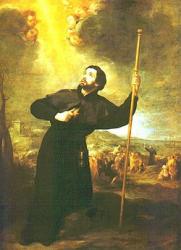
1506 - 1552 Person Name: Francis Xavier Topics: Praise and Adoration Jesus Christ Author (attributed to) of "My God, I Love Thee" in Baptist Hymnal (1975 ed) St. Francis Xavier, the great missionary saint of the Roman Catholic Church, was the son of Don John Giasso and Donna Maria d'Azpilqueta y Xavier; he was born at the castle Xavier, near Pampeluna, Spain, on April 7, 1506, and is known to history by his mother's name. At the age of eighteen he entered the University of Paris, where in due course he graduated, and then devoted himself to teaching. It was here that he became acquainted with Ignatius Loyola the founder of the Jesuits, who was then planning the colossal work which he afterwards accomplished. Xavier became one of the first nine of Loyola's converts, and the most enthusiastic of the little band. The date of the formation of the Order of the Jesuits is given as Aug. 15, 1534, and the place as Montmartre near Paris. We find Xavier at Venice with Loyola in 1537, where the visitation of a hospital for incurables was assigned to him. Here in the discharge of his duties he gave early evidence of his enthusiasm and self-devotion.
He subsequently visited Rome, where with Loyola and others of the Order he was brought, through the influence of the Rector of the University of Paris, who was then at Rome, to the notice of John III. of Portugal, who desired some of them for mission work in India. Circumstances led to the selection of Xavier for the work. He left Rome in March 1540, and set sail on April 7, 1541, for Goa, the chief city of the Portuguese possessions, where he arrived on May 6, 1542. From that time to the day of his death at Sancian, near Canton, on Dec. 22, 1552, he devoted himself to his work in a most heroic and devoted manner, visiting Travancore, Ceylon, Malacca, Japan, and other heathen lands with Cross in hand, and a burning zeal in his heart. Xavier's life has been written by many hands. The roll of deeds which he is said to have done, and the miracles he is said to have wrought, even to the raising of the dead, is long, but many of the alleged facts are open to the gravest doubt, and others are beyond belief. The hymns which are associated with Xavier's name are, "O Deus ego amo Te, Nam prior Tu amasti me," and "O Deus ego amo Te, Nee amo Te ut salves me.” That the first was written by him is most improbable, the evidence in his favour being absolutely nil. The second may possibly be his (see as above), it breathes his abnegation of self in every word, his spirit in every line. See Murray's Magazine for Oct. 1890, for an interesting account of Goa and its Cathedral, where Xavier lies buried.
--John Julian, Dictionary of Hymnology (1907)
==============
See also in:
Hymn Writers of the Church
Saint Francis Xavier
John Milton
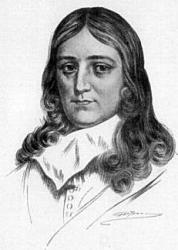
1608 - 1674 Topics: Adoration and Praise; Adoration and Praise; God Adoration and Praise Author of "Let Us with a Gladsome Mind" in Voices United Milton, John, was born in London, Dec. 9, 1608, and died there Nov. 8, 1674. His poetical excellences and his literary fame are matters apart from hymnology, and are fully dealt with in numerous memoirs. His influence on English hymn-writing has been very slight, his 19 versions of various Psalms having lain for the most part unused by hymnal compilers. The dates of his paraphrases are:—
Ps. cxiv. and cxxxvi., 1623, when he was 15 years of ago. These were given in his Poems in English and Latin 1645.
Ps. lxxx.-lxxxviii., written in 1648, and published as Nine Psalmes done into Metre, 1645.
Ps. i., 1653; ii., “Done August 8, 1653;" iii., Aug. 9, 1653; iv. Aug. 10, 1653; v., Aug. 12, 1653; vi., Aug. 13, 1653; vii.Aug. 14, 1653; viii., Aug. 14, 1653.
These 19 versions were all included in the 2nd ed. of his Poems in English and Latin, 1673. From these, mainly in the form of centos, the following have come into common use:—
1. Cause us to see Thy goodness, Lord. Ps. lxxxv.
2. Defend the poor and desolate. Ps. lxxxii.
3. God in the great assembly stands. Ps. lxxxii.
4. How lovely are Thy dwellings fair. Ps. lxxxiv. From this, "They pass refreshed the thirsty vale," is taken.
5. Let us with a gladsome [joyful] mind. Ps. cxxxvi.
6. O let us with a joyful mind. Ps. cxxxvi.
7. The Lord will come and not be slow. Ps. lxxxv.
Of these centos Nos. 4 and 5 are in extensive use. The rest are mostly in Unitarian collections. There are also centos from his hymn on the Nativity, "This is the month, and this the happy morn" (q.v.).
--John Julian, Dictionary of Hymnology (1907)
John Milton
Robert Jackson

1840 - 1914 Topics: Adoration and Praise Composer of "TRENTHAM" in Christian Youth Hymnal After receiving his musical training at the Royal Academy of Music, Robert Jackson (b, Oldham, Lancashire, England, 1840; d. Oldham, 1914) worked briefly as organist at St. Mark's Church, Grosvenor Square, in London. But he spent most of his life as organist at St. Peter's Church in Oldham (1868-1914), where his father had previously been organist for forty-eight years. A composer of hymn tunes, Jackson was also the conductor of the Oldham Music Society and Werneth Vocal Society.
Bert Polman
Robert Jackson
Jimmy Owens
1930 - 2023 Topics: Adoration and Praise God Our Father; Adoration and Praise God Our Father; Adoration and Praise God Our Father Composer of "FAIRHILL" in The Hymnal for Worship and Celebration Owens, James Lloyd (Jimmy). (Clarksdale, Mississippi, December 9, 1930-- ). Foursquare. Attended Millsaps College, Jackson, Miss.; Southwestern College, Memphis, Tennessee; Cathedral School of the Bible, Oakland, California; Cabot College, San Leandro, Calif. Minister of Music, The Neighborhood Church, Oakland, Calif., 1951-1966; Minister of Music, United Community Church, Glendale, Calif., 1966-1968; Minister of Music, Anaheim Christian Center (now Melodyland Christian Center), Anaheim, Calif., 1968-1969.
With his wife Carol, Owens has composed four Christian musicals. He has recorded several albums.
--Terry W. York, DNAH Archives
Jimmy Owens
George Whitefield
1714 - 1770 Person Name: Rev. George Whitefield, 1714-1770 Topics: Christ Praise and Adoration of Alterer of "Awake, and sing the song of Moses and the Lamb" in Hymnal and Liturgies of the Moravian Church
George Whitefield
Elizabeth Cecilia Clephane
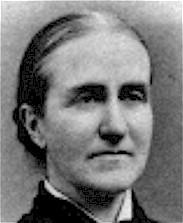
1830 - 1869 Person Name: Elizabeth C. Clephane, 1830-1869 Topics: Angels Adoring God Author of "Beneath the cross of Jesus " in Methodist Hymn and Tune Book Clephane, Elizabeth Cecilia, third daughter of Andrew Clephane, Sheriff of Fife, was born at Edinburgh, June 18, 1830, and died at Bridgend House, near Melrose, Feb. 19, 1869. Her hymns appeared, almost all for the first time, in the Family Treasury, under the general title of Breathings on the Border. In publishing the first of these in the Treasury, the late Rev. W. Arnot, of Edinburgh, then editor, thus introduced them:—
"These lines express the experiences, the hopes, and the longings of a young Christian lately released. Written on the very edge of this life, with the better land fully, in the view of faith, they seem to us footsteps printed on the sands of Time, where these sands touch the ocean of Eternity. These footprints of one whom the Good Shepherd led through the wilderness into rest, may, with God's blessing, contribute to comfort and direct succeeding pilgrims."
The hymns, together with their dates,are:—
1. Beneath the cross of Jesus. Family Treasury, 1872, p. 398,
2. Mine eyes for ever closed. Family Treasury, 1872, p. 398.
3. Who climbeth up too nigh. Family Treasury, 1872, p. 552.
4. Into His summer garden. Family Treasury, 1873, p. 245.
5. From my dwelling midst the dead. Family Treasury, 1873, p. 365.
6. The day is drawing nearly done. Family Treasury, 1873, p. 389.
7. Life-light waneth to an end. Family Treasury, 1874, p. 595.
8. There were ninety and nine that safely lay. Family Treasury, 1874, p. 595.
Of these Nos. 1 and 8 are in common use. [Rev. James Mearns, M.A.]
--John Julian, Dictionary of Hymnology (1907)
Elizabeth Cecilia Clephane
William W. Walford
1772 - 1850 Topics: Adoration and Praise Prayer Service Author of "Sweet hour of prayer, sweet hour of prayer" in The Hymnal William W. Walford, a blind preacher of England, is the author of the hymn beginning "Sweet hour of prayer." This hymn first appeared in print in the New York Observer September 13, 1845. The contributor who furnished the hymn says:
"During my residence at Coleshill, Warwickshire, England, I became acquainted with W. W. Walford, the blind preacher, a man of obscure birth and connections and no education, but of strong mind and most retentive memory. In the pulpit he never failed to select a lesson well adapted to his subject, giving chapter and verse with unerring precision, and scarcely ever misplacing a word in his repetition of the Psalms, every part of the New Testament, the prophecies, and some of the histories, so as to have the reputation of knowing the whole Bible by heart."
Rev. Thomas Salmon, who was settled as the pastor of the Congregational Church at Coleshill in 1838, remained until 1842, and then removed to the United States, is believed to have been the contributor who says of the hymn: "I rapidly copied the lines with my pencil as he uttered them, and send them for insertion in the Observer if you think them worthy of preservation."
From: Nutter, C. S., & Tillett, W. F. (1911). The hymns and hymn writers of the church, an annotated edition of The Methodist hymnal. New York: Methodist Book Concern.
William W. Walford
William Walker
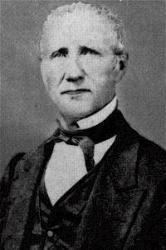
1809 - 1875 Person Name: William Walker (1809-1875) Topics: Adoration Composer of "WONDROUS LOVE" in Common Praise (1998)
William Walker
John Marriott
1780 - 1825 Person Name: J. Marriott, 1780-1825 Topics: Adoration Of the Trinity; The Godhead Adoration and Praise; Trinity Adored Author of "Thou, whose almighty word" in Methodist Hymn and Tune Book Marriott, John, M.A, son of E. Marriott, D.D., Rector of Cottesbach, near Lutterworth, was born at Cottesbach, in 1780, and educated at Rugby, and Christ Church, Oxford. He was the second of two who obtained honours in the schools in 1802, the first year in which there was a public examination for honours at Oxford. He was also Student of Christ Church, and for about two years a private tutor in the family of the Duke of Buccleuch. The Duke presented him to the Rectory of Church Lawford, Warwickshire. This he retained to his death, although his wife's health compelled him to reside in Devonshire, where he was successively curate of St. Lawrence and other parishes in Exeter, and of Broadclyst, near Exeter, where he died March 31, 1825. His published works include a volume of Sermons which he issued in 1818, and a posthumous volume of Sermons, published by his sons in 1838. His hymns were never published by himself, nor in book form by any one. A few appeared in print during his lifetime, but without his permission. These include:—
1. A saint? 0 would that I could claim. Holiness desired. "Written off almost at the moment, on hearing the name applied in a scornful way at a party, about 1813." It was printed in The Friendly Visitor, 1834.
2. Thou, Whose Almighty word. Missions. Written, his son says, "about 1813." It was printed in The Friendly Visitor, July, 1825, in 4 st. of 11., with the Title "Missionary Hymn," and without signature. This text differs only in two or three words from the original as supplied by the author's son to Dr. Rogers and published by him in his Lyra Brittanica, 1867, p. 395. Two texts are known which are received as original, the first the undoubted text in Lyra Brittanica, and the second that given by Lord Selborne from the Collection of Dr. Baffles, Congregational Minister of Liverpool.
3. When Christ our human form did bear. Christ's love of Children. “Written in 1816 for the Parochial Schools, Upottery, Devon."
-- John Julian, Dictionary of Hymnology (1907)
=================
Marriott, J. , p. 715, i., No. 1, is in the Fuller-Maitland Hymns for Private Devotion, 1827.
--John Julian, Dictionary of Hymnology, Appendix, Part II (1907)
John Marriott
J. Wilbur Chapman

1859 - 1918 Topics: Adoration and Praise Jesus Our Savior Author of "Our Great Savior" in The Celebration Hymnal Rv John Wilbur Chapman DD LLD USA 1859-1918. Born in Richmond, IN, he attended Quaker Day School and Methodist Sunday school. At age 17 he made a public declaration of his Christian faith and joined the Richmond Presbyterian Church. He received his seminary degree from Lane Theoloical Seminary, Cincinnati, OH. He was later awarded a Doctorate in Divinity from the College of Wooster, and an LL.D. from Heidelberg University. In 1882 he married Irene Steddon. They had a daughter. His wife died in 1886. In 1888 he married Agnes Pruyn Strain, and they had four children. His second wife died in 1907. In 1910 he married Mabel Cornelia Moulton. He held six pastorates in OH, IN, NY, PA, NY, NY before becoming an evangelist, generally traveling with gospel singer, Charles Alexander. In 1893 he preached with D. L. Moody. Billy Sunday was one of his disciples on the circuit. In 1895 he was appointed Corresponding Secretary of the Presbyterian General Assembly's Committeee on Evangelism, overseeing activities of 51 evangelists in 470 cities. He developed campaign tactics to maximize evangelical successes, trying them first in Pittsburgh, then Syracuse. With funding from philanthropist, John H. Converse, a wealthy Presbyterian, Chapman joined with Alexander to launch evangelical campaigns in 1907. He assembled 21 evangelistic teams after that to cover 42 sections of Philadelphia, preaching for several weeks. 8000 conversions resulted. They repeated this in NC. In 1909 they started a worldwide campaign in Vancouver, BC, and took in cities in Australia, the Phillipines, China, Korea, and Japan. Chapman also held religious summer conferences at Winona Lake, IN, Montreat, NC, and Long Island, NY. Mass evangelism was losing favor in 1910, so he was back holding large revivals with Alexander in 1912. He was also elected moderator of the Presbyterian Church General Assembly, and under so much stress, he developed gall stones. The surgery was too much, and he died two days later. He was also a prolific writer of religious works and hymn lyrics. 19 works.
John Perry
J. Wilbur Chapman
Michael Praetorius

1571 - 1621 Topics: Adoration and Praise Adapter of "PUER NOBIS NASCITUR" in Voices United Born into a staunchly Lutheran family, Michael Praetorius (b. Creuzburg, Germany, February 15, 1571; d. Wolfenbüttel, Germany, February 15, 1621) was educated at the University of Frankfort-an-der-Oder. In 1595 he began a long association with Duke Heinrich Julius of Brunswick, when he was appointed court organist and later music director and secretary. The duke resided in Wolfenbüttel, and Praetorius spent much of his time at the court there, eventually establishing his own residence in Wolfenbüttel as well. When the duke died, Praetorius officially retained his position, but he spent long periods of time engaged in various musical appointments in Dresden, Magdeburg, and Halle. Praetorius produced a prodigious amount of music and music theory. His church music consists of over one thousand titles, including the sixteen-volume Musae Sionae (1605-1612), which contains Lutheran hymns in settings ranging from two voices to multiple choirs. His Syntagma Musicum (1614-1619) is a veritable encyclopedia of music and includes valuable information about the musical instruments of his time.
Bert Polman
Michael Praetorius
James McGranahan
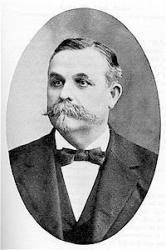
1840 - 1907 Person Name: James McGranahan, 1840-1907 Topics: Elements of Worship Praise and Adoration Composer of "MY REDEEMER" in Lift Up Your Hearts James McGranahan USA 1840-1907. Born at West Fallowfield, PA, uncle of Hugh McGranahan, and son of a farmer, he farmed during boyhood. Due to his love of music his father let him attend singing school, where he learned to play the bass viol. At age 19 he organized his first singing class and soon became a popular teacher in his area of the state. He became a noted musician and hymns composer. His father was reluctant to let him pursue this career, but he soon made enough money doing it that he was able to hire a replacement farmhand to help his father while he studied music. His father, a wise man, soon realized how his son was being used by God to win souls through his music. He entered the Normal Music School at Genesco, NY, under William B Bradbury in 1861-62. He met Miss Addie Vickery there. They married in 1863, and were very close to each other their whole marriage, but had no children. She was also a musician and hymnwriter in her own right. For a time he held a postmaster’s job in Rome, PA. In 1875 he worked for three years as a teacher and director at Dr. Root’s Normal Music Institute. He because well-known and successful as a result, and his work attracted much attention. He had a rare tenor voice, and was told he should train for the operatic stage. It was a dazzling prospect, but his friend, Philip Bliss, who had given his wondrous voice to the service of song for Christ for more than a decade, urged him to do the same. Preparing to go on a Christmas vacation with his wife, Bliss wrote McGranahan a letter about it, which McGranahan discussed with his friend Major Whittle. Those two met in person for the first time at Ashtubula, OH, both trying to retrieve the bodies of the Bliss’s, who died in a bridge-failed train wreck. Whittle thought upon meeting McGranahan, that here is the man Bliss has chosen to replace him in evangelism. The men returned to Chicago together and prayed about the matter. McGranahan gave up his post office job and the world gained a sweet gospel singer/composer as a result. McGranahan and his wife, and Major Whittle worked together for 11 years evangelizing in the U.S., Great Britain, and Ireland. They made two visits to the United Kingdom, in 1880 and 1883, the latter associated with Dwight Moody and Ira Sankey evangelistic work. McGranahan pioneered use of the male choir in gospel song. While holding meetings in Worcester, MA, he found himself with a choir of only male voices. Resourcefully, he quickly adapted the music to those voices and continued with the meetings. The music was powerful and started what is known as male choir and quartet music. Music he published included: “The choice”, “Harvest of song”, “Gospel Choir”,, “Gospel hymns #3,#4, #5, #6” (with Sankey and Stebbins), “Songs of the gospel”, and “Male chorus book”. The latter three were issued in England. In 1887 McGranahan’s health compelled him to give up active work in evangelism. He then built a beautiful home, Maplehurst, among friends at Kinsman, OH, and settled down to the composition of music, which would become an extension of his evangelistic work. Though his health limited his hours, of productivity, some of his best hymns were written during these days. McGranahan was a most lovable, gentle, modest, unassuming, gentleman, and a refined and cultured Christian. He loved good fellowship, and often treated guests to the most delightful social feast. He died of diabetes at Kinsman, OH, and went home to be with his Savior.
John Perry
James McGranahan
Carolina Sandell
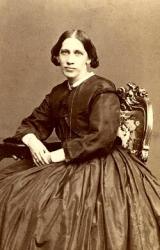
1823 - 1903 Person Name: Caroline V. Sandell-Berg Topics: Adoration and Praise Author of "Children of the Heavenly Father" in The United Methodist Hymnal Caroline W. Sandell Berg (b. Froderyd, Sweden, 1832; d. Stockholm, Sweden, 1903), is better known as Lina Sandell, the "Fanny Crosby of Sweden."
"Lina" Wilhelmina Sandell Berg was the daughter of a Lutheran pastor to whom she was very close; she wrote hymns partly to cope with the fact that she witnessed his tragic death by drowning. Many of her 650 hymns were used in the revival services of Carl O. Rosenius, and a number of them gained popularity particularly because of the musical settings written by gospel singer Oskar Ahnfelt. Jenny Lind, the famous Swedish soprano, underwrote the cost of publishing a collection of Ahnfelt's music, Andeliga Sänger (1850), which consisted mainly of Berg's hymn texts.
Bert Polman
Carolina Sandell
Brian A. Wren
b. 1936 Person Name: Brian Wren, b. 1936 Topics: Praise and Adoration Author of "Christ Is Alive!" in New Wine In Old Wineskins Brian Wren (b. Romford, Essex, England, 1936) is a major British figure in the revival of contemporary hymn writing. He studied French literature at New College and theology at Mansfield College in Oxford, England. Ordained in 1965, he was pastor of the Congregational Church (now United Reformed) in Hockley and Hawkwell, Essex, from 1965 to 1970. He worked for the British Council of Churches and several other organizations involved in fighting poverty and promoting peace and justice. This work resulted in his writing of Education for Justice (1977) and Patriotism and Peace (1983). With a ministry throughout the English-speaking world, Wren now resides in the United States where he is active as a freelance lecturer, preacher, and full-time hymn writer. His hymn texts are published in Faith Looking Forward (1983), Praising a Mystery (1986), Bring Many Names (1989), New Beginnings (1993), and Faith Renewed: 33 Hymns Reissued and Revised (1995), as well as in many modern hymnals. He has also produced What Language Shall I Borrow? (1989), a discussion guide to inclusive language in Christian worship.
Bert Polman
Brian A. Wren
Jennie Evelyn Hussey
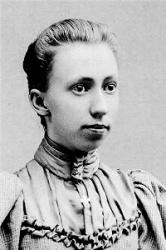
1874 - 1958 Person Name: Jennie E. Hussey Topics: Adoration of Jesus Christ; Adoration of Jesus Christ Author of "Lead Me to Calvary" in The Worshiping Church Jane Evelyn Hussy was born 8 February 1874 in Henniker, N.H. She was an invalid from rheumatism. She began writing verse as a child. The first were published when she was thirteen. At sixteen she began to write stories, articles and designs for crochet needlework for magazines. In 1898 her first hymns were published. She was a member of the Society of Friends.
Dianne Shapiro, from "The Singers and Their Songs: sketches of living gospel hymn writers" by Charles Hutchinson Gabriel (Chicago: The Rodeheaver Company, 1916)
Jennie Evelyn Hussey
Louis F. Benson
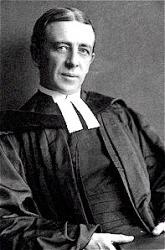
1855 - 1930 Person Name: Louis Fitzgerald Benson, 1855-1930 Topics: Adoration and Praise Author of "O Sing a Song of Bethlehem" in Hymns for a Pilgrim People Benson, Louis FitzGerald, D.D., was born at Philadelphia, Penn., July 22, 1855, and educated at the University of Penn. He was admitted to the Bar in 1877, and practised until 1884. After a course of theological studies he was ordained by the Presbytery of Philadelphia North, in 1888. His pastorate of the Church of the Redeemer, Germantown, Phila., extended from his ordination in 1888 to 1894, when he resigned and devoted himself to literary and Church work at Philadelphia. He edited the series of Hymnals authorised for use by the General Assembly of the Presbyterian Church in the U.S.A., as follows:—
(1) The Hymnal, Phila., 1895; (2) The Chapel Hymnal, 1898; and (3) The School Hymnal, 1899.
Dr. Benson's hymnological writings are somewhat extensive. They include:—
(1) Hymns and Verses (original and translations), 1897; (2) The Best Church Hymns, 1898; (3) The Best Hymns, 1898; (4) Studies of Familiar Hymns, 1903, &c.
Of his original hymns the following have come into American common use:—
I. In The Hymnal, 1895:—
1. O Christ, Who didst our tasks fulfil. For Schools and Colleges. Written in 1894.
2. O risen Christ, Who from Thy throne. For Installation of a Pastor. Written in 1894.
II. In The School Hymnal, 1899:—
3. A glory lit the wintry sky. Loneliness of Jesus. Written in 1897.
4. Happy town of Salem. Heaven.
5. Now the wintry days are o'er. Easter.
6. O sing a song of Bethlehem. Early Life of Jesus.
7. Open the door to the Saviour. Invitation.
8. Out of the skies, like angel eyes. Lullaby.
9. Who will teach me how to pray? Prayer. In Carey Bonner's Sunday School Hymnary, 1905:—
10. The sun is on the land and sea. Morning.
11. Our wilful hearts have gone astray. Penitence.
12. When I awake from slumber. Morning.
Of the above, Nos. 1-4, 10-12 are from Hymns and Verses, 1897. In the above collection by C. Bonner, Nos. 1, 4, and 6 are also found. Of Dr. Benson's translations from the Latin one only is in common use. See "Plaudite coeli, Rideat aether."
As a hymn writer Dr. Benson is not widely known, mainly through the recent publication of his verse. His hymns deserve attention, and will, no doubt, gain the public ear in due time; whilst his hymnological researches and publications are thorough and praiseworthy.
--John Julian, Dictionary of Hymnology, New Supplement (1907)
Louis F. Benson
Hubert P. Main

1839 - 1925 Topics: Worship Adoration and Praise; Adoration and Praise Arranger of "ELLESDIE" in The Hymnbook Hubert Platt Main DD USA 1839-1925. Born at Ridgefield, CT, he attended singing school as a teenager. In 1854 he went to New York City and worked as an errand boy in a wallpaper house. The next year he became an errand boy in the Bristow & Morse Piano Company. He was an organist, choir leader, and compiled books of music. He also helped his father edit the “Lute Songbook” by Isaac Woodbury. In 1866 he married Olphelia Louise Degraff, and they had two sons: Lucius, and Hubert. In 1867 he filled a position at William B Bradbury’s publishing house. After Bradbury’s death in 1868 the Bigelow & Main Publishers were formed as its successor. He also worked with his father until his father’s death in 1873. Contributors to their efforts were Fanny Crosby, Ira Sankey, Wilbur Crafts, and others. In addition to publishing, Main wrote 1000+ pieces of music, including part song, singing school songs, Sunday school music, hymns, anthems, etc. He also arranged music and collected music books. He 1891 he sold his collection of over 3500 volumes to the Newberry Library in Chicago, IL, where they were known as the Main Library. Some of his major publications include: “Book of Praise for the Sunday school” (1875), “Little pilgrim songs” (1884), “Hymns of Praise” (`1884), “Gems of song for the Sunday school” (1901), “Quartettes for men’s voices: Sacred & social selections” (1913). In 1922 Hope Publishing Company acquired Bigelow & Main. He was an editor, author, compiler, and composer, as well as publisher. He died in Newark, NJ.
John Perry
Hubert P. Main
Franz Schubert
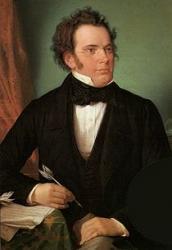
1797 - 1828 Topics: Adore the Lord; Adoration and Praise God Our Father; Adoration and Praise Jesus Our Savior Composer of "HOLY IS THE LORD" in The Celebration Hymnal Franz Peter Schubert, 31 January 1797 – 19 November 1828) was an Austrian composer.
In a short lifespan of just 31 years, Schubert was a prolific composer, writing some 600 Lieder, nine symphonies (including the famous "Unfinished Symphony"), liturgical music, operas, some incidental music, and a large body of chamber and solo piano music. Appreciation of Schubert's music during his lifetime was limited, but interest in his work increased significantly in the decades following his death. Franz Liszt, Robert Schumann, Johannes Brahms and Felix Mendelssohn, among others, discovered and championed his works in the 19th century. Today, Schubert is seen as one of the leading exponents of the early Romantic era in music and he remains one of the most frequently performed composers.
Early life and education
Schubert was born in Himmelpfortgrund (now a part of Alsergrund), Vienna, on 31 January 1797. His father, Franz Theodor Schubert, the son of a Moravian peasant, was a parish schoolmaster; his mother, Elisabeth Vietz, was the daughter of a Silesian master locksmith, and had also been a housemaid for a Viennese family prior to her marriage. Of Franz Theodor's fourteen children (one illegitimate child was born in 1783), nine died in infancy; five survived. Their father was a well-known teacher, and his school in Lichtental, a part of Vienna's 9th district, was well attended. He was not a musician of fame or with formal training, but he taught his son some elements of music.
At the age of five, Schubert began receiving regular instruction from his father and a year later was enrolled at his father's school. His formal musical education also started around the same time. His father continued to teach him the basics of the violin, and his brother Ignaz gave him piano lessons. At the age of seven, Schubert began receiving lessons from Michael Holzer, the local church organist and choirmaster. Holzer's lessons seem to have mainly consisted of conversations and expressions of admiration and the boy gained more from his acquaintance with a friendly joiner's apprentice who used to take him to a neighboring pianoforte warehouse where he had the opportunity to practice on better instruments. He also played the viola in the family string quartet, with brothers Ferdinand and Ignaz on violin and his father on the cello. Schubert wrote many of his early string quartets for this ensemble.
Schubert first came to the attention of Antonio Salieri, then Vienna's leading musical authority, in 1804, when his vocal talent was recognized. In October 1808, he became a pupil at the Stadtkonvikt (Imperial seminary) through a choir scholarship. At the Stadtkonvikt, Schubert was introduced to the overtures and symphonies of Mozart. His exposure to these pieces and various lighter compositions, combined with his occasional visits to the opera set the foundation for his greater musical knowledge. One important musical influence came from the songs of Johann Rudolf Zumsteeg, who was an important Lied composer of the time, which, his friend Joseph von Spaun reported, he "wanted to modernize". Schubert's friendship with Spaun began at the Stadtkonvikt and endured through his lifetime. In those early days, the more well-to-do Spaun furnished the impoverished Schubert with manuscript paper.
Meanwhile, his genius began to show in his compositions. Schubert was occasionally permitted to lead the Stadtkonvikt's orchestra, and Salieri decided to begin training him privately in musical composition and theory in these years. It was the first germ of that amateur orchestra for which, in later years, many of his compositions were written. During the remainder of his stay at the Stadtkonvikt he wrote a good deal of chamber music, several songs, some miscellaneous pieces for the pianoforte and, among his more ambitious efforts, a Kyrie (D. 31) and Salve Regina (D. 27), an octet for wind instruments (D. 72/72a, said to commemorate the 1812 death of his mother), a cantata for guitar and male voices (D. 110, in honor of his father's birthday in 1813), and his first symphony (D. 82).
At the end of 1813, he left the Stadtkonvikt, and returned home for studies at the Normalhauptschule to train as a teacher. In 1814, he entered his father's school as teacher of the youngest students. For over two years, the young man endured the drudgery of the work, which he performed with very indifferent success. There were, however, other interests to compensate. He continued to receive private lessons in composition from Salieri, who did more for Schubert’s musical training than any of his other teachers. Salieri and Schubert would part ways in 1817.
In 1814, Schubert met a young soprano named Therese Grob, the daughter of a local silk manufacturer. Several of his songs (Salve Regina and Tantum Ergo) were composed for her voice, and she also performed in the premiere of his first Mass (D. 105) in September 1814. Schubert intended to marry Grob, but was hindered by the harsh marriage consent law of 1815, which required the ability to show the means to support a family. In November 1816, after failing to gain a position at Laibach, Schubert sent Grob's brother Heinrich a collection of songs, which were retained by her family into the 20th century.
One of Schubert's most prolific years was 1815. He composed over 20,000 bars of music, more than half of which was for orchestra, including nine church works, a symphony, and about 140 Lieder. In that year, he was also introduced to Anselm Hüttenbrenner and Franz von Schober, who would become his lifelong friends. Another friend, Johann Mayrhofer, was introduced to him by Spaun in 1814. Maynard Solomon suggested that Schubert was erotically attracted to men, a thesis that has, at times, been heatedly debated. Musicologist and Schubert expert Rita Steblin claimed that he was "chasing women".
Supported by friends
Significant changes happened in 1816. Schober, a student of good family and some means, invited Schubert to room with him at his mother's house. The proposal was particularly opportune, for Schubert had just made the unsuccessful application for the post of Kapellmeister at Laibach, and he had also decided not to resume teaching duties at his father's school. By the end of the year, he became a guest in Schober's lodgings. For a time, he attempted to increase the household resources by giving music lessons, but they were soon abandoned, and he devoted himself to composition. "I compose every morning, and when one piece is done, I begin another." During this year, he focused on orchestral and choral works, although he also continued to write Lieder. Much of this work was unpublished, but manuscripts and copies circulated among friends and admirers.
In early 1817, Schober introduced Schubert to Johann Michael Vogl, a prominent baritone twenty years Schubert's senior. Vogl, for whom Schubert went on to write a great many songs, became one of Schubert's main proponents in Viennese musical circles. He also met Joseph Hüttenbrenner (brother to Anselm), who also played a role in promoting Schubert's music. These, and an increasing circle of friends and musicians, became responsible for promoting, collecting, and, after his death, preserving his work.
In late 1817, Schubert's father gained a new position at a school in Rossau (not far from Lichtental). Schubert rejoined his father and reluctantly took up teaching duties there. In early 1818, he was rejected for membership in the prestigious Gesellschaft der Musikfreunde, something that might have furthered his musical career. However, he began to gain more notice in the press, and the first public performance of a secular work, an overture performed in February 1818, received praise from the press in Vienna and abroad.
Schubert spent the summer of 1818 as music teacher to the family of Count Johann Karl Esterházy at their château in Zseliz (then in Hungary, now in Slovakia). His duties were relatively light (teaching piano and singing to the two daughters, Marie and Karoline), and the pay was relatively good. As a result, he happily continued to compose during this time. It may have been at this time that he wrote one of his now world-famous compositions, the Marche militaire No. 1 in D major. Marie and Karoline both being his piano students, and the original score of "Marche Militaire" being a piano duet, lend credence to this view. On his return from Zseliz, he took up residence with his friend Mayrhofer. The respite at Zseliz led to a succession of compositions for piano duet.
During the early 1820s, Schubert was part of a close-knit circle of artists and students who had social gatherings together that became known as "Schubertiaden". The tight circle of friends with which Schubert surrounded himself was dealt a blow in early 1820. Schubert and four of his friends were arrested by the Austrian police, who (in the aftermath of the French Revolution and Napoleonic Wars) were on their guard against revolutionary activities and suspicious of any gathering of youth or students. One of Schubert's friends, Johann Senn, was put on trial, imprisoned for over a year, and then permanently forbidden to enter Vienna. The other four, including Schubert, were "severely reprimanded", in part for "inveighing against [officials] with insulting and opprobrious language". While Schubert never saw Senn again, he did set some of his poems, "Selige Welt" and "Schwanengesang", to music. The incident may have played a role in a falling-out with Mayrhofer, with whom he was living at the time.
He was nicknamed "Schwämmerl" by his friends, which Gibbs describes as translating to "Tubby" or "Little Mushroom". "Schwammerl" is Austrian (and other) dialect for mushroom; the umlaut makes it a diminutive.
Musical maturity
The compositions of 1819 and 1820 show a marked advance in development and maturity of style. The unfinished oratorio "Lazarus" (D. 689) was begun in February; later followed, amid a number of smaller works, by the 23rd Psalm (D. 706), the Gesang der Geister (D. 705/714), the Quartettsatz in C minor (D. 703), and the "Wanderer Fantasy" for piano (D. 760). Of most notable interest is the staging in 1820 of two of Schubert's operas: Die Zwillingsbrüder (D. 647) appeared at the Theater am Kärntnertor on 14 June, and Die Zauberharfe (D. 644) appeared at the Theater an der Wien on 21 August. Hitherto, his larger compositions (apart from his masses) had been restricted to the amateur orchestra at the Gundelhof, a society which grew out of the quartet-parties at his home. Now he began to assume a more prominent position, addressing a wider public. Publishers, however, remained distant, with Anton Diabelli hesitantly agreeing to print some of his works on commission. The first seven opus numbers (all songs) appeared on these terms; then the commission ceased, and he began to receive the meager pittances which were all that the great publishing houses ever paid him. The situation improved somewhat in March 1821 when Vogl sang "Der Erlkönig" at a concert that was extremely well received. That month, Schubert composed a variation on a waltz by Anton Diabelli (D. 718), being one of the fifty composers who contributed to Vaterländischer Künstlerverein.
The production of the two operas turned Schubert's attention more firmly than ever in the direction of the stage, where, for a variety of reasons, he was almost completely unsuccessful. All in all, he produced seventeen stage works, each of them failures which were quickly forgotten. In 1822, Alfonso und Estrella was refused, partly owing to its libretto. Fierrabras (D. 796) was rejected in the fall of 1823, but this was largely due to the popularity of Rossini and the Italian operatic style, and the failure of Carl Maria von Weber's Euryanthe. Die Verschworenen (The Conspirators, D. 787) was prohibited by the censor (apparently on the grounds of its title), and Rosamunde (D. 797) was withdrawn after two nights, owing to the poor quality of the play for which Schubert had written incidental music. Of these works, the two former are written on a scale which would make their performances exceedingly difficult (Fierrabras, for instance, contains over 1,000 pages of manuscript score), but Die Verschworenen is a bright attractive comedy, and Rosamunde contains some of the most charming music that Schubert ever composed. In 1822, he made the acquaintance of both Weber and Beethoven, but little came of it in either case. Beethoven is said to have acknowledged the younger man's gifts on a few occasions, but some of this is likely legend and in any case he could not have known the real scope of Schubert's music – especially not the instrumental works – as so little of it was printed or performed in the composer's lifetime. On his deathbed, Beethoven is said to have looked into some of the younger man's works and exclaimed, "Truly, the spark of divine genius resides in this Schubert!" but what would have come of it if he had recovered we can never know.
Last years and masterworks
Despite his preoccupation with the stage, and later with his official duties, Schubert found time during these years for a significant amount of composition. He completed the Mass in A flat (fr) (D. 678) and, in 1822, embarked suddenly on a work which more decisively than almost any other in those years showed his maturing personal vision, the "Unfinished Symphony" in B minor. The reason he left it unfinished after two movements and sketches some way into a third remains an enigma, and it is also remarkable that he did not mention it to any of his friends even though, as Brian Newbould notes, he must have felt thrilled by what he was achieving. The event has been debated endlessly without resolution.
In 1823 Schubert, in addition to Fierrabras, also wrote his first song cycle, Die schöne Müllerin (D. 795), setting poems by Wilhelm Müller. This series, together with the later cycle "Winterreise" (D. 911, also setting texts of Müller in 1827) is widely considered one of the pinnacles of Lieder. He also composed the song Du bist die Ruh ("You are stillness/peace") D. 776 during this year. Also in that year, symptoms of syphilis first appeared.
In 1824, he wrote the variations for flute and piano on "Trockne Blumen", from the cycle Die schöne Müllerin, and several string quartets. He also wrote the Arpeggione Sonata (D. 821), at a time when there was a minor craze over that instrument. In the spring of that year he wrote the Octet in F (D. 803), "A Sketch for a Grand Symphony"; and in the summer went back to Zseliz. There he became attracted to Hungarian musical idiom, and wrote the Divertissement à la hongroise (D. 818) for piano duet and the String Quartet in A minor (D. 804). It has been said that he held a hopeless passion for his pupil, the Countess Karoline Eszterházy, but the only work he dedicated to her was his Fantasie in F minor (D. 940) for piano duet.
The setbacks of previous years were compensated for by the prosperity and happiness of 1825. Publication had been moving more rapidly; the stress of poverty was for a time lightened; and in the summer he had a pleasant holiday in Upper Austria, where he was welcomed with enthusiasm. It was during this tour that he produced his "Songs from Sir Walter Scott". This cycle contains Ellens dritter Gesang (D. 839), a setting of Adam Storck's German translation of Scott's hymn from The Lady of the Lake, which is widely, though mistakenly, referred to as "Schubert's Ave Maria". It opens with the greeting Ave Maria, which recurs in the refrain; the entire Scott/Storck text in Schubert's song is frequently substituted with the complete Latin text of the traditional Ave Maria prayer. In 1825, Schubert also wrote the Piano Sonata in A minor (Op. 42, D. 845), and began the "Great" C major
Franz Schubert
Nolan Williams
Person Name: Nolan Williams, Jr. b. 1969 Topics: Worship and Adoration Arranger of "NICAEA" in African American Heritage Hymnal
Nolan Williams
Christian H. Bateman
1813 - 1889 Topics: Adoration; Praise, Adoration, Worship, Exaltation of God Author of "Come, Christians, Join to Sing" in Baptist Hymnal 2008 Bateman, Christian Henry, son of John Bateman, was born Aug. 9, 1813, at Wyke, near Halifax. After studying in the Moravian Church and exercising his ministry there for a time, he became, in 1843, minister of Richmond Place Congregational Church, Edinburgh. After 1846 he was successively Congregational minister at Hopton, in Yorkshire, and Beading, in Berkshire. On taking Holy Orders in the Church of England he became, 1869-71, curate of St. Luke's, Jersey, and Chaplain to the Forces; 1871-75, Vicar of All Saints, Childshill, Middlesex; 1877-84, curate of St. John's, Penymynydd, Hawarden. His hymns appeared mainly in:—
The Sacred Song Book (Edin., Gall & Inglis, subsequently published as Sacred Melodies for Children; and as 200 Sacred Melodies for Sunday Schools and Families, was edited by himself, with the Rev. James Gall, and latterly with Mr. Robert Inglis, the publisher. First pub. 1843 as 25; enlarged by a second part, 1846, to 60; revised and enlarged, 1854, to 80; 1862, to 130; and 1872, to 200; it reached a circulation of a million and a half before 1862, four millions before 1872, and above six millions before 1881. It was for many years the hymnbook for Sabbath School use in Scotland. (2) The Children's Hymnal and Christian Year (London., J. Hodges, 1872), including 11 original hymns, with others from many sources. His best known hymn is: “Come, children, join to sing" (q. v.). [Rev. James Mearns, M.A.]
-- John Julian, Dictionary of Hymnology (1907)
=======================
Bateman, C. H., p. 116, i. He finally resided at Carlisle without a charge, and died there in July, 1889.
--John Julian, Dictionary of Hymnology, Appendix, Part II (1907)
Christian H. Bateman
Luther B. Bridgers
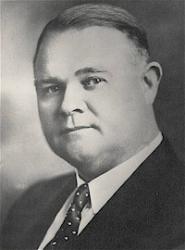
1884 - 1948 Topics: Praise, Adoration, Worship, Exaltation of Jesus Author of "He Keeps Me Singing" in Baptist Hymnal 2008 Luther Burgess Bridgers Born at Margarettsville, NC, son of a minister who conducted revival meetings, he assisted his father conducting meetings (1904-1913). He attended Asbury College at Wilmore, KY, and met his wife, Sarah Jane (Sallie) Veatch in 1905 while there. They had three sons: Luther Hughes, Allen Veatch, and James Marvin. He pastored Methodist Episcopal congregations in KY, NC, and GA, first pastoring in Perry, FL, before doing evangelistic work. He evangelized in the southern U S. He was also known for his fine singing voice and would sing at each meeting. Tragedy struck while he was conducting a revival in Middlesboro, KY, in 1911. Having left his wife and three sons to visit his wife’s parents while he was away, he learned that they had all perished in a house fire. In 1914 he remarried to Aline Winburn, and they had a son, Luther B Jr. After WW1 he took part in missionary outreaches to Belgium, Czechoslovakia, Poland and Russia. He often spoke to large crowds and saw many come to Christ. In 1914 he was also named ‘General Evangelist’ of his denomination. In 1921 Asbury College awarded him an honorary DD degree for his evangelistic efforts. He pastored at several Methodist churches in the Atlanta, GA, area, then briefly at a Methodist church at Morehead, NC. After his long ministry, ending in 1945, he retired and moved to Gainesville, GA, where he eventually died. He was known as ‘Melody Man’. He penned a number of hymns, eight of which were published in Charlie Tillman’s ‘The Revival No. 6’. His most famous, noted below, borrowed a tune from a popular song of the time, ‘Melody of Love’.
John Perry
Luther B. Bridgers
Bryan Jeffery Leech
1931 - 2015 Topics: Worship and Adoration Author of "Brethren, We Have Met to Worship" in Hymns for the Family of God Bryan Jeffrey Leech was born in Middlesex, England in 1931. He came to the United States in 1955 and studied at Barrington College and North Park Seminary. He was ordained in 1961 and served in the Covenant Church. He composed more than 500 songs.
Dianne Shapiro
Bryan Jeffery Leech
Miriam Therese Winter
b. 1938 Topics: Adoration and Praise God Author (st. 4) of "For the Beauty of the Earth" in The New Century Hymnal
Miriam Therese Winter
Anna Letitia Waring
1823 - 1910 Person Name: Anna L. Waring, 1823-1910 Topics: Adoration Author of "In Heavenly Love Abiding" in Ambassador Hymnal See also in:
Hymn Writers of the Church
================
Waring, Anna Laetitia, daughter of Elijah Waring, and niece of Samuel Miller Waring, was born at Neath, Glamorganshire, in 1820. In 1850 she published her Hymns and Meditations, by A. L. W., a small book of 19 hymns. The 4th edition was published in 1854. The 10th edition, 1863, is enlarged to 38 hymns. She also published Additional Hymns, 1858, and contributed some pieces to the Sunday Magazine, 1871. Her most widely known hymns are: "Father, I know that all my life," "Go not far from me, O my Strength," and "My heart is resting, O my God." The rest in common use include:—
1. Dear Saviour of a dying world. Resurrection. (1854.)
2. In heavenly love abiding. Safety in God. (1850.)
3. Jesus, Lord of heaven above. Love to Jesus desired. (1854.)
4. Lord, a happy child of Thine. Evening. (1850.)
5. My Saviour, on the [Thy] words of truth. Hope in the Word of God. (1850.) Sometimes stanza iv., "It is not as Thou wilt with me," is given separately.
6. O this is blessing, this is rest. Rest in the Love of Jesus. (1854.)
7. O Thou Lord of heaven above. The Resurrection.
8. Source of my life's refreshing springs. Rest in God. (1850.)
9. Sunlight of the heavenly day. New Year (1854.)
10. Sweet is the solace of Thy love. Safety and Comfort in God. (1850.)
11. Tender mercies on my way. Praise of Divine Mercies. (1850.)
12. Thanksgiving and the voice of melody. New Year (1854).
13. Though some good things of lower worth. Love of God in Christ, (1860.)
These hymns are marked by great simplicity, concentration of thought, and elegance of diction. They are popular, and deserve to be so. [George Arthur Crawford, M.A.]
-- John Julian, Dictionary of Hymnology (1907)
===============
Waring, Anna L., p. 1233, ii. Of her hymns we have found the following in Lovell Squire's Selection of Scriptural Poetry, 3rd ed., 1848:
1. Father, I know that all my life, p. 367, ii.
2. Sweet is the solace of Thy love, p. 1233, ii. 10.
3. Though some good things of, &c., p. 1233, ii. 13.
The statement in J. Telford's The Methodist Hymn Book Illustrated, 1906, p. 271, that Miss Waring contributed to her uncle's (S. M. Waring's) Sacred Melodies, 182G, cannot be correct, as she was then only six years old. [Rev. James Mearns, M.A.]
--John Julian, Dictionary of Hymnology, New Supplement (1907)
Anna Letitia Waring
Mary E. Byrne
1880 - 1931 Person Name: Mary E. Byrne, 1880-1931 Topics: Adoration Translator of "Be Thou My Vision" in Ambassador Hymnal Mary Elizabeth Byrne, M.A. (July 2, 1880 – January 19, 1931) was born in Ireland.
She translated the Old Irish Hymn, "Bí Thusa 'mo Shúile," into English as "Be Thou My Vision" in Ériu (the journal of the School of Irish Learning), in 1905.
See also in:
Wikipedia
Mary E. Byrne
Jan Struther
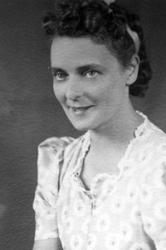
1901 - 1953 Person Name: Jan Struther, 1901-1953 Topics: Adoration and Praise Author of "Lord of All Hopefulness" in Hymns for a Pilgrim People Jan Struther, given name: Joyce Torrens-Graham [sic Joyce Anstruther] (b. Westminster, London, England, 1901; d. New York, NY, 1953) wrote many poems and essays under the pen name of Jan Struther (derived from her mother's maiden name, Eva Anstruther). In addition to her pen name, Struther also had the married names of Mrs. Anthony Maxtone Graham and, from a second marriage, Mrs. Adolf Kurt Placzek. During World War II she moved with her children to New York City and remained there until her death. In England she is best known for her novel Mrs. Miniver (1940), which consists of sketches of British family life before World War II. Immensely popular, the book was later made into a movie. Struther also wrote comic and serious poetry, essays, and short stories, published in Betsinda Dances and Other Poems (1931), Try Anything Twice (1938), The Glass Blower (1941), and, posthumously, The Children's Bells (1957). Songs of Praise (1931) included twelve of her hymn texts.
Bert Polman
Jan Struther
William M. Runyan
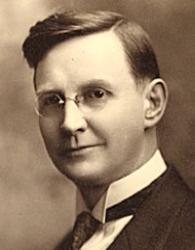
1870 - 1957 Topics: Adoration and Praise Composer of "FAITHFULNESS" in The United Methodist Hymnal Showing early musical promise, William Marion Runyan (b. Marion, NY, 1870; d. Pittsburg, KS, 1957) was a substitute church organist by the age of twelve. He became a Methodist minister in 1891 and served several churches in Kansas but turned to evangelism in 1903; he worked for the Central Methodist Conference for the next twenty years. Following that service, Runyan became pastor at the Federated Church at John Brown University, Sulphur Springs, Arkansas. Editor of Christian Workers Magazine, he also served the Moody Bible Institute and was an editor for Hope Publishing Company until his retirement in 1948. Runyan wrote a number of hymn texts, gospel songs, and hymn tunes.
Bert Polman
William M. Runyan
Cecil Frances Alexander
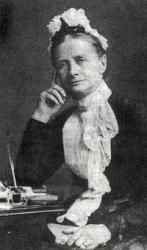
1818 - 1895 Person Name: Cecil F. Alexander, 1818-1895 Topics: General Worship Adoration and Praise; Adoration Author of "All Things Bright and Beautiful" in Baptist Hymnal 1956 As a small girl, Cecil Frances Humphries (b. Redcross, County Wicklow, Ireland, 1818; Londonderry, Ireland, 1895) wrote poetry in her school's journal. In 1850 she married Rev. William Alexander, who later became the Anglican primate (chief bishop) of Ireland. She showed her concern for disadvantaged people by traveling many miles each day to visit the sick and the poor, providing food, warm clothes, and medical supplies. She and her sister also founded a school for the deaf. Alexander was strongly influenced by the Oxford Movement and by John Keble's Christian Year. Her first book of poetry, Verses for Seasons, was a "Christian Year" for children. She wrote hymns based on the Apostles' Creed, baptism, the Lord's Supper, the Ten Commandments, and prayer, writing in simple language for children. Her more than four hundred hymn texts were published in Verses from the Holy Scripture (1846), Hymns for Little Children (1848), and Hymns Descriptive and Devotional ( 1858).
Bert Polman
==================
Alexander, Cecil Frances, née Humphreys, second daughter of the late Major John Humphreys, Miltown House, co. Tyrone, Ireland, b. 1823, and married in 1850 to the Rt. Rev. W. Alexander, D.D., Bishop of Derry and Raphoe. Mrs. Alexander's hymns and poems number nearly 400. They are mostly for children, and were published in her Verses for Holy Seasons, with Preface by Dr. Hook, 1846; Poems on Subjects in the Old Testament, pt. i. 1854, pt. ii. 1857; Narrative Hymns for Village Schools, 1853; Hymns for Little Children, 1848; Hymns Descriptive and Devotional, 1858; The Legend of the Golden Prayers 1859; Moral Songs, N.B.; The Lord of the Forest and his Vassals, an Allegory, &c.; or contributed to the Lyra Anglicana, the S.P.C.K. Psalms and Hymns, Hymns Ancient & Modern, and other collections. Some of the narrative hymns are rather heavy, and not a few of the descriptive are dull, but a large number remain which have won their way to the hearts of the young, and found a home there. Such hymns as "In Nazareth in olden time," "All things bright and beautiful," "Once in Royal David's city," "There is a green hill far away," "Jesus calls us o'er the tumult," "The roseate hues of early dawn," and others that might be named, are deservedly popular and are in most extensive use. Mrs. Alexander has also written hymns of a more elaborate character; but it is as a writer for children that she has excelled.
- John Julian, Dictionary of Hymnology (1907)
===============
Alexander, Cecil F., née Humphreys, p. 38, ii. Additional hymns to those already noted in this Dictionary are in common use:—
1. Christ has ascended up again. (1853.) Ascension.
2. His are the thousand sparkling rills. (1875.) Seven Words on the Cross (Fifth Word).
3. How good is the Almighty God. (1S48.) God, the Father.
4. In [a] the rich man's garden. (1853.) Easter Eve.
5. It was early in the morning. (1853.) Easter Day.
6. So be it, Lord; the prayers are prayed. (1848.) Trust in God.
7. Saw you never in the twilight? (1853.) Epiphany.
8. Still bright and blue doth Jordan flow. (1853.) Baptism of Our Lord.
9. The angels stand around Thy throne. (1848.) Submission to the Will of God.
10. The saints of God are holy men. (1848.) Communion of Saints.
11. There is one Way and only one. (1875.) SS. Philip and James.
12. Up in heaven, up in heaven. (1848.) Ascension.
13. We are little Christian children. (1848.) Holy Trinity.
14. We were washed in holy water. (1848.) Holy Baptism.
15. When of old the Jewish mothers. (1853.) Christ's Invitation to Children.
16. Within the Churchyard side by side. (1848.) Burial.
Of the above hymns those dated 1848 are from Mrs. Alexander's Hymns for Little Children; those dated 1853, from Narrative Hymns, and those dated 1875 from the 1875 edition of Hymns Ancient & Modern.
Several new hymns by Mrs. Alexander are included in the 1891 Draft Appendix to the Irish Church Hymnal.
--John Julian, Dictionary of Hymnology, Appendix, Part II (1907)
=============
Alexander, Cecil F. , p. 38, ii. Mrs. Alexander died at Londonderry, Oct. 12, 1895. A number of her later hymns are in her Poems, 1896, which were edited by Archbishop Alexander.
--John Julian, Dictionary of Hymnology, New Supplement (1907)
See also in:Hymn Writers of the Church
Cecil Frances Alexander
Doris Akers
1923 - 1995 Topics: Adoration and Praise Holy Spirit Author of "Sweet, Sweet Spirit" in The New Century Hymnal Doris Mae Akers USA 1923-1995. Born at Brookfield, MO, one of nine siblings, her (inter-racial) parents divorced when she was age three. She then lived with her mother, who remarried when she was age six. They lived in Kirksville, MO. Some of her brothers lived with her father after the divorce. The family attended the Bethel AME Church in Kirksville, where she learned to play piano by ear at age six. She wrote her first song at age 10. In the 1930s she formed a singing gospel group with siblings, Edward, Marian, and Donald, who went by the name ‘Dot and the Swingsters’. Early in her career (1938) she moved to Los Angeles, CA. There she became known for her work with the ‘Sky Pilot Choir’, an integrated group that made recordings and appeared on Radio and TV across the country. Her fresh, modern arrangements of traditional negro spirituals drew large crowds from far and near, and increased her church’s attendance dramatically. Her choir group released three record albums. She recorded solos in 1963 and also collaborated with the Statemen Quartet in 1964. She ended working with the choir in 1965, but reunited with it again in 1974 to make a 4th recording for RCA Victor. In 1970 she moved to Columbus, OH, where she continued composing, recording, and traveling. In the 1980s she released a new gospel album each year on a regional Midwest label. She also released a few albums in Canada (not distributed in the U S). In the 1990s she began recording for the Gaither label and appeared in some of their TV productions and concerts. She was affectionately known as ‘Miss Gospel Music’, respected and admired by everyone in the gospel music business. By this time, she had mastered vocalization, keyboards, choir directing, arranging, composing, and publishing. She worked with many of the early pioneers in gospel music and authored gospel compositions, some selling millions of records for other performers and evangelists. In her final years she was Minister of Music at Grace Temple Deliverance Center, Minneapolis, MN. In 1994 she broke her ankle, and also discovered she had spinal cancer. She died at Edina, MN. She never married. She wrote 500+ songs. She received many awards over the years, including ‘Gospel Music Composer of the Year’ (for both years 1960 and 1961). In 1976, the city of Kirksville, MO, held “Doris Akers’ Day’, featuring her as the headline act, as part of the bicentennial celebration. Over 20,000 attended the celebration there. In 1992 she was honored by the Smithsonian Institution as ‘The Foremost Gospel Writer in the U S’. Her works include eight collections of music. In 2001 she was inducted into the Gospel Music Hall of Fame. In 2011 she was inducted into the Southern Gospel Music Hall of Fame.
John Perry
Doris Akers
Robert J. Fryson
Topics: Adoration and Praise Jesus Christ Author of "Glorious Is Your Name, O Jesus" in The New Century Hymnal
Robert J. Fryson
W. G. Fischer
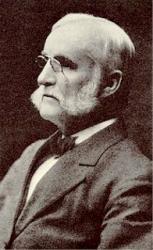
1835 - 1912 Person Name: William G. Fischer Topics: Adoration and Praise Composer of "HANKEY" in Voices United William Gustavus Fischer In his youth, William G. Fischer (b. Baltimore, MD, 1835; d. Philadelphia, PA, 1912) developed an interest in music while attending singing schools. His career included working in the book bindery of J. B. Lippencott Publishing Company, teaching music at Girard College, and co-owning a piano business and music store–all in Philadelphia. Fischer eventually became a popular director of music at revival meetings and choral festivals. In 1876 he conducted a thousand-voice choir at the Dwight L. Moody/Ira D. Sankey revival meeting in Philadelphia. Fischer composed some two hundred tunes for Sunday school hymns and gospel songs.
Bert Polman
W. G. Fischer
Jakob Hintze
1622 - 1702 Person Name: Jakob Hintze, 1622 - 1702 Topics: The Life In Christ Adoration and Praise Composer of "SALZBURG (ALLE MENSCHEN)" in Service Book and Hymnal of the Lutheran Church in America Partly as a result of the Thirty Years' War and partly to further his musical education, Jakob Hintze (b. Bernau, Germany, 1622; d. Berlin, Germany, 1702) traveled widely as a youth, including trips to Sweden and Lithuania. In 1659 he settled in Berlin, where he served as court musician to the Elector of Brandenburg from 1666 to 1695. Hintze is known mainly for his editing of the later editions of Johann Crüger's Praxis Pietatis Melica, to which he contributed some sixty-five of his original tunes.
Bert Polman
Jakob Hintze
St. John of Damascus
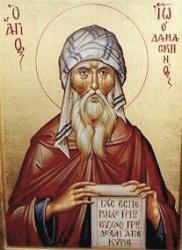
675 - 787 Person Name: John of Damascus Topics: Adoration and Praise Author of "The Day of Resurrection" in The United Methodist Hymnal Eighth-century Greek poet John of Damascus (b. Damascus, c. 675; d. St. Sabas, near Jerusalem, c. 754) is especially known for his writing of six canons for the major festivals of the church year. John's father, a Christian, was an important official at the court of the Muslim caliph in Damascus. After his father's death, John assumed that position and lived in wealth and honor. At about the age of forty, however, he became dissatisfied with his life, gave away his possessions, freed his slaves, and entered the monastery of St. Sabas in the desert near Jerusalem. One of the last of the Greek fathers, John became a great theologian in the Eastern church. He defended the church's use of icons, codified the practices of Byzantine chant, and wrote about science, philosophy, and theology.
Bert Polman
========================
John of Damascus, St. The last but one of the Fathers of the Greek Church, and the greatest of her poets (Neale). He was of a good family in Damascus, and educated by the elder Cosmas in company with his foster-brother Cosmas the Melodist (q. v.). He held some office under the Caliph. He afterwards retired to the laura of St. Sabas, near Jerusalem, along with his foster-brother. There he composed his theological works and his hymns. He was ordained priest of the church of Jerusalem late in life. He lived to extreme old age, dying on the 4th December, the day on which he is commemorated in the Greek calendar, either in his 84th or 100th year (circa 780). He was called, for some unknown reason, Mansur, by his enemies. His fame as a theologian rests on his work, the first part of which consists of philosophical summaries, the second dealing with heresies, and the third giving an account of the orthodox faith. His three orations in favour of the Icons, from which he obtained the name of Chrysorrhous and The Doctor of Christian Art, are very celebrated. The arrangement of the Octoechusin accordance with the Eight Tones was his work, and it originally contained no other Canons than his. His Canons on the great Festivals are his highest achievements. In addition to his influence on the form and music, Cardinal Pitra attributes to him the doctrinal character of the later Greek hymnody. He calls him the Thomas Aquinas of the East. The great subject round which his hymns are grouped is The Incarnation, developed in the whole earthly career of the Saviour. In the legendary life of the saint the Blessed Virgin Mary is introduced as predicting this work: the hymns of John of Damascus should eclipse the Song of Moses, rival the cherubim, and range all the churches, as maidens beating their tambours, round their mother Jerusalem (Pitra, Hymn. Grecque, p. 33). The legend illustrates not only the dogmatic cast of the hymns, but the introduction of the Theotokion and Staurotheotokion, which becomes the prevalent close of the Odes from the days of St. John of Damascus: the Virgin Mother presides over all. The Canons found under the name of John Arklas (one of which is the Iambic Canon at Pentecost) are usually attributed to St. John of Damascus, and also those under the name of John the Monk. Some doubt, however, attaches to the latter, because they are founded on older rhythmical models which is not the case with those bearing the name of the Damascene, and they are not mentioned in the ancient Greek commentaries on his hymns. One of these is the Iambic Canon for Christmas.
His numerous works, both in prose and verse, were published by Le Quien, 1712; and a reprint of the same with additions by Migne, Paris, 1864. Most of his poetical writings are contained in the latter, vol. iii. pp. 817-856, containing those under the title Carmina; and vol. iii. pp. 1364-1408, the Hymni. His Canon of SS. Peter & Paul is in Hymnographie Grecque, by Cardinal Pitra, 1867. They are also found scattered throughout the Service Books of the Greek Church, and include Iambic Canons on the Birth of Christ, the Epiphany, and on Pentecost; Canons on Easter, Ascension, the Transfiguration, the Annunciation, and SS. Peter & Paul: and numerous Idiomela. In addition, Cardinal Mai found a manuscript in the Vatican and published the same in his Spicilegium Romanum, which contained six additional Canons, viz.: In St. Basilium; In St. Chrysostomum; In St. Nicolaum; In St. Petrum; In St. Georgium, and In St. Blasium. But M. Christ has urged grave objections to the ascription of these to St. John of Damascus (Anthologia Graeca Carminum Christorium, p. xlvii.). Daniel's extracts in his Thesaurus Hymnologicus, vol. iii. pp. 80, 97, extend to six pieces. Dr. Neale's translations of portions of these works are well known. [Rev. H. Leigh Bennett, M.A.]
-- John Julian, Dictionary of Hymnology (1907)
St. John of Damascus
Lela B. Long
1896 - 1951 Person Name: Lela Long Topics: Adore the Lord; Adoration and Praise Jesus Our Savior Author of "Jesus Is the Sweetest Name I Know" in The Celebration Hymnal She’s an almost unknown personality, except for the song associated with her name. Perhaps that’s the way Lela B. Long wanted it…to be faceless, almost nameless, in favor of making His name more well-known. “Jesus Is the Sweetest Name I Know” must have been a statement her family and friends could remember her saying, but we don’t have to rely on any published biography to learn this. She recorded her opinion for us. What opinions do I have that I would want to survive me? Just any pontification probably wouldn’t last, but what makes Lela’s opinion notable is that it strikes a chord with us still today.
There’s not much information on Lela B. Long, other than a record with the words she wrote that suggests the song was written prior to 1925. That would suggest she was an adult who was born in the late 19th or early 20th Century, and went on to eternity prior to the end of the 20th Century. She must have had some affinity with people she knew, including unspoken names she says in verse one had moved her emotionally. But, she makes it clear that those names paled next to ‘Jesus’. Why would His name be so special to Long? Had she been affected by poor health, or events of her time like World War I, which robbed its survivors of friends and loved ones? What life circumstances drew her toward Him? We only know that she wrote three verses and a refrain (see the link below for access to them) to carry her message, though most often we hear only the refrain. She has us say repeatedly throughout the refrain that he’s genuine, as authentic and loveable as one can imagine Him. Isn’t that really the root of love, that this person to whom I cling is not a fake, but true? He’s worth my worship, she declares.
Can I identify with what Lela says? I live in a different time than her, but what’s really different? There are still people around, many of whom move me in different ways, as some evidently did for Lela Long in her life. She must have experienced illness, or other calamities that threatened her faith. War? The war she must have known was once known as the ‘war to end all wars’. Did it really accomplish this? How sweet was its conclusion for those who signed the peace at Versailles (see picture), if they lived to see what happened a generation later? Lies like that are too common. Likewise, health is too fragile for me to become complacent in my comfort. I must find something that won’t go sour. Lela did. It’s still pretty tasty, even decades after she savored it.
Link to the song’s scant history and the three verses that accompany the chorus-refrain: http://www.hymntime.com/tch/htm/j/i/s/jisnikno.htm
Posted by David Cain at 12:23 PM
http://songscoops.blogspot.com/2012/02/jesus-is-sweetest-name-i-know-lela-b.html
Lela B. Long
Edward Husband
1843 - 1908 Topics: Adoration Composer of "ST. EDITH" in The Psalter Husband, Edward was educated at St. Aidan's College, Birkenhead. Taking Holy Orders in 1866, he was successively Curate of Atherstone and Folkestone; and in 1878 Vicar of St. Michael and All Angels, Folkestone. In 1874 Mr. Husband published The Mission Hymnal, in which appeared his hymns as follows:—
1. Alas! poor world, I loved thee long. Rest in Jesus.
2. And dost Thou ask me, dearest Lord. Christ's Invitation, " Follow Me."
3. I must have Jesus only. Jesus only desired
4. Sweet Blood, dear ransom of our souls. The Blood of Jesus.
These hymns are very simple, earnest, and impassioned: and bear a great resemblance to Facer's compositions.
--John Julian, Dictionary of Hymnology (1907)
Edward Husband
Roberta Martin
Person Name: Roberta Martin, 1912-1969 Topics: Worship and Adoration Arranger of "[Praise God from whom all blessings flow]" in Lead Me, Guide Me (2nd ed.)
Roberta Martin
Johann G. Nägeli
Person Name: J. G. Nageli, 1768-1836 Topics: Adoration Of God; God Adoration of; The Godhead Adoration and Praise Composer of "SCOTT" in Methodist Hymn and Tune Book See Nägeli, Hans George, 1773-1836
Johann G. Nägeli
Thomas Gibbons
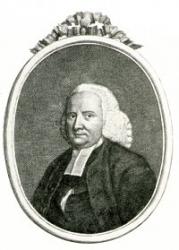
1720 - 1785 Person Name: Gibbons Topics: Adoration, Praise, and Thanksgiving Author of "Thy goodness, Lord, our souls confess" in Christian Hymns for Public and Private Worship Gibbons, Thomas, was born at Beak, near Newmarket, May 31, 1720; educated by Dr. Taylor, at Deptford; ordained in 1742, as assistant to the Rev. Mr. Bures, at Silver Street Chapel, London; and in 1743 became minister of the Independent Church, at Haberdashers' Hall, where he remained till his death, Feb. 22, 1785. In addition to his ministerial office he became, in 1754, tutor of the Dissenting Academy at Mile End, London; and, in 1759, Sunday evening lecturer at Monkwell Street. In 1760 the College at New Jersey, U.S., gave him the degree of M.A. and in 1764 that of Aberdeen the degree of D.D. His prose works were (1) Calvinism and Nonconformity defended, 1740; (2) Sermons on various subjects, 1762; (3) Rhetoric, 1767; (4) Female Worthies, 2 vols., 1777. Three volumes of sermons were published after his death. His poetical works were:—
(1) Juvenilia; Poems on various subjects of Devotion and Virtue, 1750, was published by subscription. Among the subscribers is found the name of the Rev. Mr. George Whitefield, B.A. It was dedicated to the Countess of Huntingdon, and bears her coat of arms. In this volume are included versions of six of the Psalms, and a few hymns. (2) Hymns adapted to Divine wor¬ship in two books. Book I. Derived from select passages of Holy Scriptures. Book II., Written on sacred subjects and particular occasions, partly collected front various authors, but principally composed by Thomas Gibbons, D.D., 1769. (3) Hymns adapted to Divine worship in two books. Book I. Derived from select passages of the Holy Scriptures. Book II. Written on sacred subjects and particular occasions by Thomas Gibbons, D.D., 1784. (4) The Sermons, published in 1762, included fifteen hymns, one being appended to each sermon. (5) The Christian Minister in three poetical epistles to Philander, 1772. This volume included (i.) Poetical versions of several parts of Scripture, (ii.) Translations of poems from Greek and Latin writers, (iii.) Original pieces on various occasions. (6) An English version of the Latin Epitaphs on the Nonconformist's Memorial, with a poem to the memory of the 2000 ministers ejected in 1662, 1775. (7) Select Portions of Scripture, and Remarkable Occurrences, versified for the Instruction and entertainment of Youth of both Sexes, 1781. Reprinted in America, 1805.
Dr. Gibbons may be called a disciple in hymnwriting of Dr. Watts, whose life he wrote. His hymns are not unlike those of the second rank of Watts. He lacked "the vision and faculty divine," which gives life to hymns and renders them of permanent value. Hence, although several are common use in America, they are dying out of use in Great Britain. The most popular are, "Now let our souls on wings sublime"; "Great God, the nations of the earth"; "Thy goodness, Lord, our souls confess"; "To Thee, my God, whose presence fills." [Rev. W. Garrett Horder]
The less important of Dr. Gibbons's hymns, which are still in common use are:—
1. And be it so that till this hour. Hope. This is No. 50 in Book ii. of his Hymns adapted to Divine Worship, &c, 1769, in 5 stanzas of 4 lines, and headed, "Encouragement against Despair; or, Hope still set before us." Originally a Sacramental hymn in Rippon's Selections, 1787, No 230, it was altered to a general hymn, with special reference to "Hope."
2. Assist us, Lord, Thy Name to praise. Life, a race. In Rippon's Baptist Selections, 1787, No. 326, in 4 stanzas of 4 lines.
3. Eternal life, how sweet the sound. Eternal Life. This is one of three hymns on Titus iii. 7, in his Hymns adapted to Divine Worship, &c, 1784, Book i., No. 156, in 5 stanzas of 4 lines. In the American Dutch Reformed Hymns of the Church, 1869, No. 843 begins with st. ii., "Eternal life, how will it reign?"
4. Father, is not Thy promise pledged? Missions. This is Pt. iii.of his hymn, "Great God, the nations of the earth" (q. v.).
5. Forgiveness, 'tis a joyful sound. Pardon. From his Hymns adapted to Divine Worship, &c, 1769. Book i., No. 69, in 5 stanzas of 4 lines into several modern collections in Great Britain and America. It is based on St. Luke, vii. 47.
6. From winter's barren clods. [Spring.] Appeared in his Hymns, &c, 1784, Book ii., No. 27, in 5 stanzas of 4 lines, and headed, "The Return of the Spring celebrated in the Powerful and Gracious Work of God." In 1787 it was repeated anonymously in Rippon's Baptist Selections, No. 499. The hymn, "Great God, at Thy command, Seasons in order rise," begins with st. iii. of this hymn.
7. Happy the men in ancient days. Public Worship. In his Hymns adapted to Public Worship, &c, 1784.
8. On Zion, his most holy mount. Gospel Feast. From his Hymns adapted for Divine Worship, &c, 1769, Book i., No. 35, in 6 stanzas of 4 lines. It was originally a Sacramental hymn, but in its abbreviated form, as in use in America, that element is eliminated.
9. Our Father, high enthroned above. Lord's Prayer. Appeared in the Bristol Baptist Collection of Ash & Evans, 1769, No. 41, in 9 stanzas of 4 lines. In 1772 it was reprinted in a revised form, and with an additional stanza, in Gibbons's Christian Minister, p. 74.
10. Thy goodness, Lord, our souls confess. Providence and Grace. Appeared in the Gospel Magazine, 1775, and in his Hymns adapted to Divine Worship, &c, 1784, Bk. ii., No. 11, in 7 stanzas of 4 lines. In Dobell's Selections, 1806, st. i.-iv., and vi. were given with alterations, which were not improvements, as No. 9. This arrangement is repeated in modern hymnbooks, including the Baptist Hymnal, 1879, and others.
11. When Jesus dwelt in mortal clay. Jesus our Example. From his Hymns adapted to Divine Worship, &c, 1784, Book i., No. 128, in 9 stanzas of 4 lines into a few American collections, including the Baptist Praise Book, 1871.
The more important of Dr. Gibbons's hymns are annotated under their respective first lines. [William T. Brooke]
-- John Julian, Dictionary of Hymnology (1907)
======================
Gibbons, Thomas, p. 420, i. From his Hymns, &c, of 1784, are also in common use:—
1. Lord God, omnipotent to bless. Divine Help desired.
2. Now may the God of peace and love. Close of Service. (1769. Pt. i.)
3. O what stupendous mercy shines. Benevolence.
--John Julian, Dictionary of Hymnology, Appendix, Part II (1907)
Thomas Gibbons
W. H. Havergal
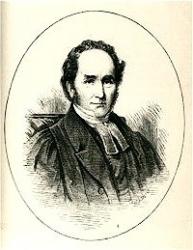
1793 - 1870 Person Name: W. H. Havergal, 1793-1870 Topics: Adoration and Worship Composer of "ADORATION" in The Methodist Hymn-Book with Tunes Havergal, William Henry, M.A, son of William Havergal, was born at High Wycombe, Buckinghamshire, 1793, and was educated at St. Edmund's Hall, Oxford (B.A. 1815, M.A. 1819). On taking Holy Orders he became in 1829 Rector of Astley, Worcestershire; in 1842, Rector of St. Nicholas, Worcester; and in 1860, Rector of Shareshill, near Wolverhampton. He was also Hon. Canon in Worcester Cathedral from 1845. He died April 18, 1870. His hymns, about 100 in all, were in many instances written for special services in his own church, and printed as leaflets. Several were included in W. Carus Wilson's Book of General Psalmody, 1840 (2nd ed., 1842); and in Metrical Psalms & Hymns for Singing in Churches, Worcester, Deighton, 1849, commonly known as the Worcester Diocesan Hymn Book, and of which he was the Editor. In Life Echoes, 1883, his hymns are given with those of Miss Havergal. Of those in common use the greater part are in Mercer, and Snepp's Songs of Grace & Glory. Although his hymns are all good, and two or three are excellent, it is not as a hymnwriter but as a musician that Canon Havergal is best known. His musical works and compositions included, in addition to numerous individual hymn tunes and chants, the Gresham Prize Service, 1836; the Gresham Prize Anthem, 1845; Old Church Psalmody, 1849; History of the Old 100th Psalm tune, 1854, &c. He also reprinted Ravenscroft’s Psalter of 1611. His hymns in common use include:—
1. Blessed Jesus, lord and Brother. School Festivals, 1833. Published in Life Echoes, 1883.
2. Brighter than meridian splendour. Christ the glory of His Church. 1830. Published in W. C. Wilson's Book of General Psalms, 1840; the Worcester Psalms & Hymns, 1849, &c.
3. Christians, awake to joy and praise. Christmas Carol, c. 1860. Printed on broadsheet, with music by the author, and sold on behalf of the Lancashire Cotton Distress Fund.
4. Come, Shepherds, come, 'tis just a year. Christmas Carol. 1860. Published in Snepp's Songs of Grace & Glory,
5. For ever and for ever, Lord. Missions, 1866, for the Church Mission Society. Published in Snepp's Songs of Grace & Glory, 1872, and the Life Echoes, 1883.
6. Hallelujah, Lord, our voices. Sunday. 1828. Published in W. C. Wilson's Book of General Psalms, 1840; the Worcester Psalms & Hymns, 1849; Life Echoes, 1883, &c.
7. Heralds of the Lord of glory. Missions. First sung in Astley Church, Sep. 23, 1827. Published in Miss Havergal's Starlight through the Shadows, 1880; Snepp's Songs of Grace & Glory, 1872, &c.
8. Hosanna, raise the pealing hymn. Praise to Christ, 1833, and first sung in Astley Church, June 9, 1833. Published in W. C. Wilson's Book of General Psalmody, 1840; the Worcester Psalms & Hymns, 1849; Life Echoes 1883, &c.
9. How vast the field of souls. Missions. 1858. Printed for Shareshill Church Miss. Anniversary, 1863, and published in Snepp's Songs of Grace & Glory, 1872, and the Life Echoes, 1883.
10. In doubt and dread dismay. Missions. Written in 1837, and published in W. C. Wilson's Book of General Psalmody, 1840; the Worcester Psalms & Hymns, 1849, &c.
11. Jerusalem the golden, The home of saints shall be. Heaven. Published in Life Echoes, 1883.
12. My times are in Thy hand, Their best, &c. 1860. Published in Snepp's Songs of Grace & Glory, 1872, the Records of the author's life and work, and Life Echoes, 1883. The editor of the Records says (p. 159) "this hymn has been much appreciated, and well illustrates the devotional and cheerful spirit of the writer."
13. No dawn of holy light. Sunday. 1825. Printed in 1831 on a leaflet, and published in W. C. Wilson's Book of General Psalmody, 1840; the Worcester Psalms & Hymns, 1849; Life Echoes, 1883, &c.
14. Our faithful God hath sent us. Harvest. Written at Shareshill in 1863, for a Harvest Festival. Published in Snepp's Songs of Grace & Glory 1872, and Life Echoes, 1883.
15. Shout, 0 earth! from silence waking. Praise to Jesus for Redemption. 1841. Published in the Worcester Psalms & Hymns, 1849; Snepp's Songs of Grace & Glory, 1872, &c.
16. So happy all the day. Christmas Carol, c. 1834. Published in Snepp's Songs of Grace & Glory, 1872.
17. Soon the trumpet of salvation. Missions. 1826. Published in Snepp's Songs of Grace & Glory, 1872.
18. To praise our Shepherd's [Saviour's] care. The Good Shepherd. Written after witnessing the death of Elizabeth Edwards, aged 12, of St. Nicholas, Worcester, and printed as a leaflet. Published in W. C. Wilson's Book of General Psalmody, 1840; the Worcester Psalms & Hymns, 1849; Life Echoes, &c, 1883. The author also published a Memoir of the child.
19. Widely 'midst the slumbering nations. Missions. 1828. Published in the Worcester Psalms & Hymns, 1849; Snepp's Songs of Grace & Glory, 1872, &c.
In addition to these hymns, his carols, "How grand, and how bright," "Our festal morn is come," and others are annotated under their respective first lines. Most of these carols and hymns were reprinted in Christmas Carols & Sacred Songs, Chiefly by the Rev. W. H. Havergal, London, Nisbet, 1869.
--John Julian, Dictionary of Hymnology (1907)
=====================
Havergal, W. H., p. 498, i. Other hymns are: —
1. Lord, if judgments now are waking. Second Advent. Published in W. Carus Wilson's Book of General Psalmody, 1840; in Kennedy, 1863, &c.
2. Remember, Lord, Thy word of old displayed. Missions. "Composed for a special prayer-meeting for missionary labourers, held in the author's schoolroom, in the parish of St. Nicholas's, Worcester." (W. F. Stevenson's Hymns for Church and Home, 1873, where the original text is also given.)
It must be noted that No. 17, at p. 498, ii., "Soon the trumpet of salvation," was first published in A Collection of Original Airs adapted to Hymns, &c, 1826.
--John Julian, Dictionary of Hymnology, Appendix, Part II (1907)
W. H. Havergal
John Hughes
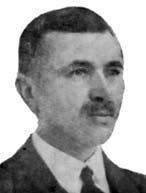
1873 - 1932 Person Name: John Hughes, 1873-1932 Topics: Adoration Composer of "CWM RHONDDA" in Worship and Rejoice John Hughes (b. Dowlais, Glamorganshire, Wales, 1873; d. Llantwit Fardre, Wales, 1932) received little formal education; at age twelve he was already working as a doorboy at a local mining company in Llantwit Fardre. He eventually became an official in the traffic department of the Great Western Railway. Much of his energy was devoted to the Salem Baptist Church in Pontypridd, where he served as both deacon and precentor. Hughes composed two anthems, a number of Sunday school marches, and a few hymn tunes, of which CWM RHONDDA is universally known, the tune was composed in 1905 Baptist Cymanfa Ganu (song festival) in Capel Rhondda, Pontypridd, Wales.
Bert Polman
John Hughes
William Penfro Rowlands
1860 - 1937 Person Name: William Penfro Rowlands (1860--1937) Topics: Adoration Composer of "BLAENWERN" in Ancient and Modern
William Penfro Rowlands
Eddie A. Robinson
Topics: Praise and Adoration Author of "We Study, We Shout, We Serve" in New Wine In Old Wineskins
Eddie A. Robinson
B. B. Beall
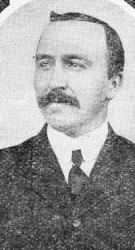
1874 - 1945 Topics: Worship and Adoration Composer of "[How to reach the masses, men of ev'ry birth]" in Yes, Lord! Benjamin Burke (B. B.) Beall, was born on May 25, 1874, Dallas, Georgia. Benjamin graduated in music and elocution from the Texas Musical Institute. He ran the B. B. Beall publishing company in Douglasville, Georgia. He died on October 7, 1945, in Douglasville, Georgia.
Some of his publications:
Bright Beautiful Bells (Birmingham, Alabama: B. B. Beal & Company, 1900)
Gems for the Sunday Schools (Douglasville, Georgia: B. B. Beall & Company, 1902)
Lasting Songs, B. B. Beall et al (Douglasville, Georgia: B. B. Beall & Company, 1910)
NN, Hymnary editor. Source: www.hymntime.com/tch/
B. B. Beall
William J. Maher
1823 - 1877 Person Name: William J. Maher, SJ, 1823-1877 Topics: Devotions Adoration of the Blessed Sacrament Composer of "ANIMA CHRISTI" in Journeysongs (3rd ed.)
William J. Maher
Christopher M. Idle
b. 1938 Person Name: Christopher Idle Topics: Approaching God Adoration and Thanksgiving Author (vs. 3-5) of "Round the Lord in glory seated" in Praise! psalms hymns and songs for Christian worship Christopher Martin Idle (b. Bromley, Kent, England, 1938) was educated at Elthan College, St. Peter's College, Oxford, and Clifton Theological College in Bristol, and was ordained in the Church of England. He served churches in Barrow-in-Furness, Cumbria; London; and Oakley, Suffolk; and recently returned to London, where he is involved in various hymnal projects. A prolific author of articles on the Christian's public responsibilities, Idle has also published The Lion Book of Favorite Hymns (1980) and at least one hundred of his own hymns and biblical paraphrases. Some of his texts first appeared in hymnals published by the Jubilate Group, with which he is associated. He was also editor of Anglican Praise (1987). In 1998 Hope Publishing released Light Upon the River, a collection of 279 of his psalm and hymn texts, along with suggested tunes, scripture references, and commentary.
Bert Polman
Christopher M. Idle


 My Starred Hymns
My Starred Hymns


